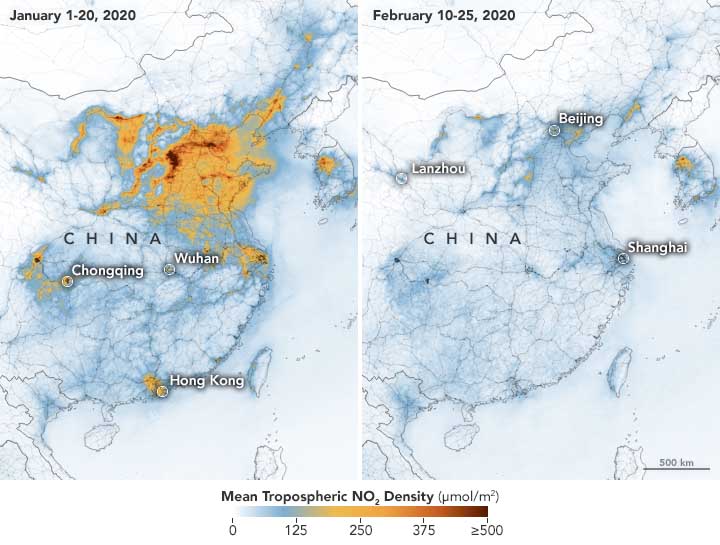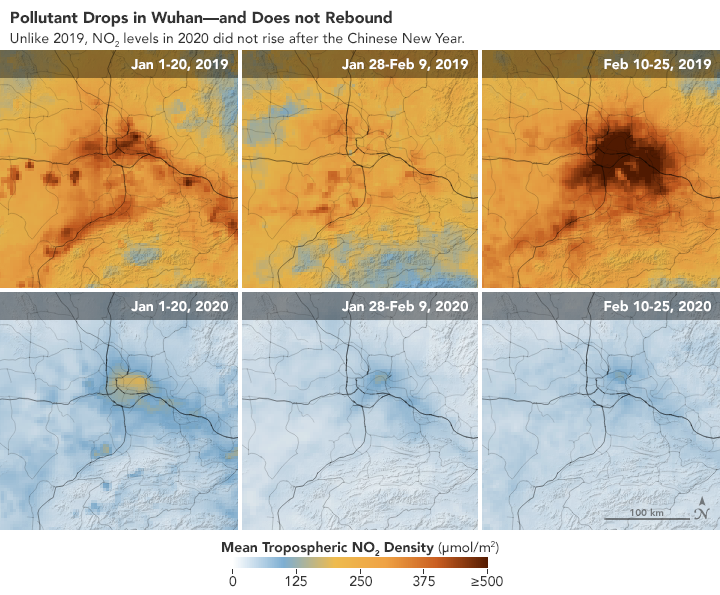Dramatic effect of coronavirus lockdowns seen from space
The air above China cleaned up faster than ever before in living memory.

The new coronavirus' impact on China is so stark that it can be seen from space — as a dramatic drop in air pollution, according to data from U.S. and European satellites.
Orbital instruments designed to monitor air quality picked up a substantial drop in concentration of nitrogen dioxide (NO2) pollution since January. NO2 is a harmful substance emitted by gas vehicles, power plants and other machines that burn fossil fuels. The decline is likely related to an economic slowdown and travel restrictions in China since the virus became widespread, according to a statement from NASA Earth Observatory.
"This is the first time I have seen such a dramatic drop-off over such a wide area for a specific event," Fei Liu, an air quality researcher at NASA’s Goddard Space Flight Center, said in the statement.
Related: Live updates on COVID-19
A NASA Earth Observatory image, visible at the top of this article, shows an astonishing decline in NO2 between January and the start of February.
Liu said that there have been other incidents that led to measurable NO2 decreases, including the 2008 economic recession. But none have been so intense or happened so quickly. She also noted that there's often a noticeable drop-off around this time as China celebrates the Lunar New Year, but that it's never before been so stark.
"This year, the reduction rate is more significant than in past years and it has lasted longer," she said. "I am not surprised because many cities nationwide have taken measures to minimize spread of the virus."
Get the Space.com Newsletter
Breaking space news, the latest updates on rocket launches, skywatching events and more!
The Chinese government has closed business and restricted travel between cities. Wuhan, the city where the outbreak began, has been the subject of especially harsh measures. The impact of those measures is reflected in local pollution levels; a map of the city shows an astonishing drop in NO2 levels between Jan. 1 and Feb. 25.

As the virus continues to spread worldwide and governments continue to take measures to fight it, such second-order impacts could show up around the globe.
- 12 coronavirus myths busted by science
- Earth pictures: iconic images of Earth from space
- 10 deadly diseases that hopped across species
Originally published on Live Science.
OFFER: Save at least 53% with our latest magazine deal!
With impressive cutaway illustrations that show how things function, and mindblowing photography of the world’s most inspiring spectacles, How It Works represents the pinnacle of engaging, factual fun for a mainstream audience keen to keep up with the latest tech and the most impressive phenomena on the planet and beyond. Written and presented in a style that makes even the most complex subjects interesting and easy to understand, How It Works is enjoyed by readers of all ages.
Join our Space Forums to keep talking space on the latest missions, night sky and more! And if you have a news tip, correction or comment, let us know at: community@space.com.

Rafi wrote for Live Science from 2017 until 2021, when he became a technical writer for IBM Quantum. He has a bachelor's degree in journalism from Northwestern University’s Medill School of journalism. You can find his past science reporting at Inverse, Business Insider and Popular Science, and his past photojournalism on the Flash90 wire service and in the pages of The Courier Post of southern New Jersey.











